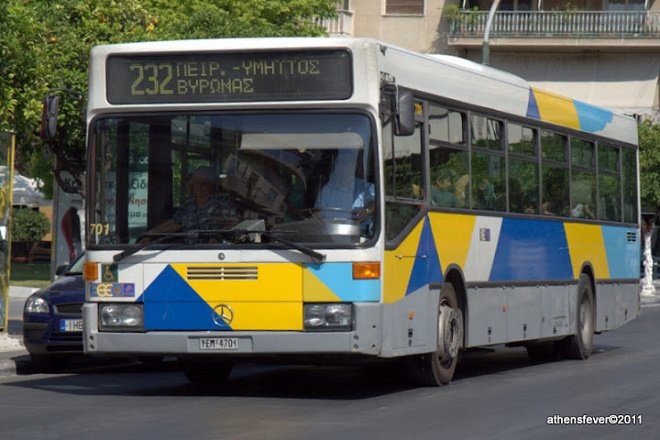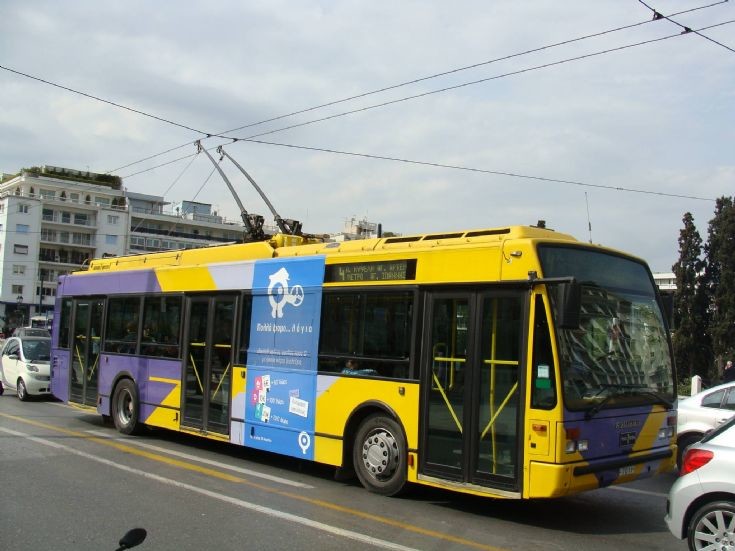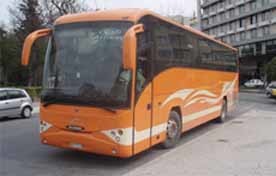Transport in Athens: the bus.
And we’ve arrived at the last mode of transport in Athens (without counting the taxi): the bus. In general, every neighbourhood had its own buses, and many reach fairly central areas. In this entry, I will tell you about the most useful, especially for moving around the city, which go to the universities and the busiest points, and which ones will allow you to leave the city for trips.
There are maps of the buses in the information and tourism centres, as well as in the bus stops, where you can also find the timetables. Inside, they announce the name of the next stop and, in some, there are televisions installed with the routes that they take.
For more information, you can visit the company’s official sites: telematics. oasa.gr and www.oasa.gr.
First of all, in Greek they say:
* bus: το λεωφορείο (to leoforío)
* stop: η στάση (i stasi)
And not for nothing, as well as Google Maps (which saves everybody), I would recommend you download the Google Play app: Athens Next Bus (melato. bus. android) on melato.org, that definitely works for Android.
City Buses

There are two types of urban buses: trolley (yellow) and buses (blue). The difference is basically that the trolley runs on electricity, connected to the cables that run along their route.
As I wrote in an earlier entry, you have to buy the tickets before getting on board the vehicle, in metro stations or kiosks. You can validate them in the machines inside the bus or trolley. To find the prices and fares, I wrote them here: Transport in Athens: the Metro.
- General timetables: are at every bus stop according to the line, but from Monday to Friday, they normally run from 5am to 11pm. Saturdays and Sundays have a different timetable and the frequency tends to be reduced.
- Night timetables: from 00:30 am or on 24-hour operatives. The latter runs day and night without changing the route.
- Frequency: from 10 to 20 minutes during the day, depending on the line. During the night and on the weekends, from 20 to 30 minutes.

Universities:
Well, as we are talking about getting around by bus, I will not elaborate in depth about what faculties there are in each campus of area. If you come as an Erasmus student, I am sure that you will find out before I do where you need to go.
1. Zografou campus: Lines 140, 220, 221, 224
2. Faculties along Patission Street: Lines 3, 5, 11
3. Faculty of Fine Arts (Pireas Street): Lines 049, 914 (from Athens street, Omonoia)
4. Panteion University: Lines 10, 106, 136, 550, A2 (from Sigrou Fix), B2
5. Faculty of Agriculture: Lines 856, 813
6. Faculty of Architecture and offices (28 Oktovriou Street): Lines 3, 5, 11, 608, 622
Centre and beaches:
- The 035 and the 060 are the most useful for crossing the centre and heading towards Kypseli or Kolonaki, among many other routes that pass through these areas.
- The 040 (from Syntagma) and the 049 (from Omonoia) head towards the Pireas area.
- The trolley lines 2, 3, 4, 9, 11, 13 and 15 run from the National Gardens to the central street of Patission, passing through Syntagma.
- To go to the beaches: A2, A3, B3, E2 (from Acadimias), the 149 (from the Glyfada Square) and the 171 (from Dafni towards Varkiza).
Night Buses:
- 040 (Syntagma – Pireas): 24 hours every day
- 500 (Pireas – Kifissia): Green Line route on the metro. Tuesday to Sunday it operates from 00:30am to 4:30am. On Mondays from 1:20am to 4:30am.
- 790 (Glyfada – Peristeri): Red Line route on the metro. Every day from 00:30am to 4:30 am.
- X14 (Syntagma – Kifissia): Mondays to Fridays: 20:00 to 05:30am. On weekends it operates 24 hours.
- 11 (Ano Patissia – Pangrati – Nea Elvetia): 24 hours every day.
* Likewise, all Express buses to and from the airport run for 24 hours. *
Express Buses:
- E14 (Syntagma – OAKA – Minist Education): Mondays to Fridays from 5:30am to 22:00
- E15 (Larissa Station – TEI – Larissa St): circle line. Every day from 7am to 11:30am (runs every hour, approximately).
- E90 (Pireas – Campus): every day from 7:20am to 16:30 (runs every two and a half hours, approximately).
- X14 (Syntagma – Kifissia): Monday to Friday: 20:00 to 5:30am. At the weekends, it runs for 24 hours. (Runs every 45 minutes approximately).
Express to and from the airport
They run for 24 hours, but everyone has a different timetable. The prices to the airport are always higher, and you can buy the ticket at the station.
· Regular price: 6 euros
· Reduced Price: 3 euros
- X93 (Av. Kifissios – Airport): it won’t be useful for those of you who aren’t around the Peristeri and Kifissias Avenue area, or if you are coming back from a trip and end up in the bus terminal. Frequency: every 50 or 70 minutes.
- X95 (Syntagma – Airport): This is the one you want! Frequency: every 20 minutes.
- X96 (Pireas – Airport): of you live near to the port, it would more useful for you to head to the centre via the metro. Frequency: every 40 minutes.
- X97 (Elliniko – Airport): from the end of the Red Line. Frequency: every 70 minutes.
Intercity Buses

There are various ways to reach the external areas of Athens, to other cities in the country or to journey to the nearby countries by bus. I, for example, went to Tirana (Albania) by bus, about 12 hours sat down, but touring through all of Greece has its charm. Being Erasmus, travelling is the nice part of the year, taking advantage of being closer than ever to places that you would otherwise have never had the opportunity to visit so easily.
Albania, Hungary and Turkey
As I said before, I took a trip to the Albanian capital by bus, that departs from the localised station in the Karaiskaki Square, in Metaksourgio. It cost me no more than 40 euros, although I should point out that the journey, given the distance between cities, should not have been so long, but the roads in Greece aren’t very well-amended.
You will find the prices and routes in the same station, so if you live in the centre, which is the most typical, come here. In the metro Red Line, it’s very easy: it’s nearly in front of the exit, surrounded by many travel offices and taxi garages.
Exterior of Athens: Sounio, Marathon, Megara, Lavrio…
These buses belong to the company KTEL (Attiki) and are an orange colour. Their main station is in the middle of the centre, in the extreme of the Av. Alexandras, in front of a large park (in the intersection with 28 Oktovriou Street, easy access from Victoria Station (metro Green Line)).
Prices: You can buy tickets beforehand or pay for them “in situ”. A ticket inspector will board and ask for you to show them it. Prices tend to be around 7 euros, depending on where you go (for example, it’s only 5 euros to go to Marathon). Here you will find them specifically: ktelattikis
· Frequency: every 2 hours, more or less, so try to not miss them. In any case, make sure to check before leaving to look at the specific timetable for each destination on the official site.
It will be most useful for you to visit Sounio and Marathon above all, as they are the most popular destinations, for their historical character. In Sounio, the bus will leave you in front of Poseidon’s Temple, which is gorgeous, surrounded by what little remains of the old houses that were there. The most common is also to go to see the sunset. But, pay attention as to when the last return bus is! You don’t want to end up stuck.
From Athens to other cities: Thessaloniki, Patras, Ioannina, Peloponeso...
There are two terminals:
- Terminal A: at 100 Av. Kifissos (in Peristeri) from where you can go to Peloponeso, cross to Macedonia (FYROM is the name of the country, according to the Greeks), or to the Ionian Islands.
- Terminal B: in Liossian Street (bus from the metro station Attiki (Red Line)). It heads towards cities in the northern area of the country.
As these buses also require planning, I recommend that you ask in an office or in the same stations for the prices and timetables of each route, since each one is specific.
And here so far, the general information on transport has ended. I hope that this has been more helpful than confusing, and that whatever else you need, I am sure Google can almost always help you.
If you have managed to organise yourself, you can start to observe the details of Athens more peacefully.
Photo gallery
Content available in other languages
- Español: Transporte de Atenas: el autobús.
- Italiano: I trasporti di Atene: l'autobus
Want to have your own Erasmus blog?
If you are experiencing living abroad, you're an avid traveller or want to promote the city where you live... create your own blog and share your adventures!
I want to create my Erasmus blog! →


















Comments (0 comments)